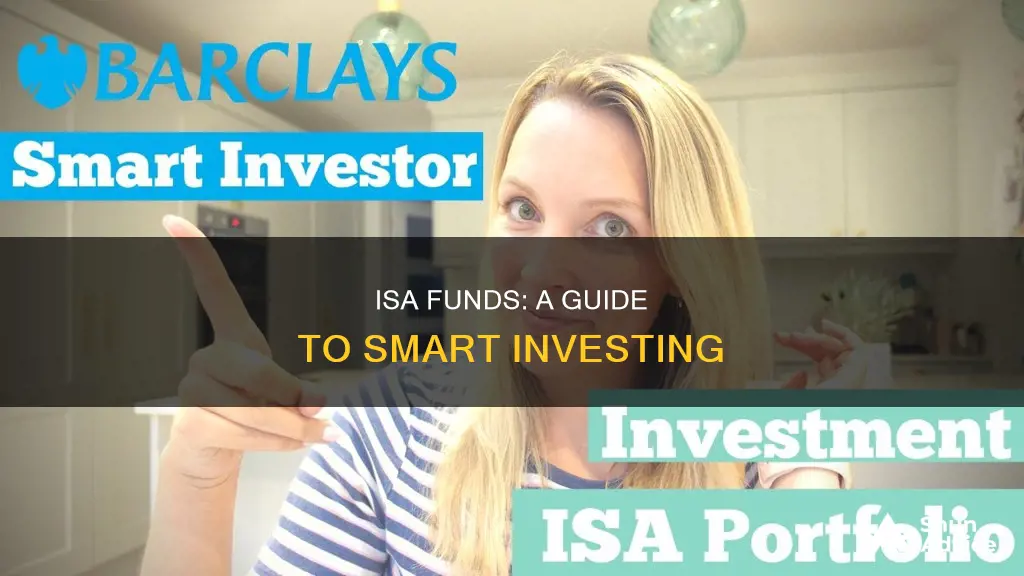
Investing in Individual Savings Accounts (ISAs) is a great way to get started with investing. ISAs are tax-efficient 'wrappers' for your money, meaning that you don't pay tax on any income or capital gains you earn from your investments. In the 2024-25 tax year, you can invest up to £20,000 in an ISA, choosing from four different types: cash, stocks and shares, innovative finance, or lifetime. Stocks and shares ISAs are considered higher risk than cash ISAs, but they also have the potential for higher returns. You can invest in almost anything with a stocks and shares ISA, from shares and bonds to more exotic options like farmland, vintage cars, and wine. However, most investors stick to shares and funds. It's important to remember that there are no guarantees when investing, and the value of your investments can go down as well as up.
| Characteristics | Values |
|---|---|
| Annual allowance | £20,000 |
| Annual allowance expiry | 5 April |
| Minimum amount to open a Stocks and Shares ISA | £50 |
| Types of ISA | Cash, Stocks and Shares, Innovative Finance, Lifetime |
| Maximum amount in a Lifetime ISA | £4,000 |
| Annual CGT allowance | £3,000 |
| Tax-free dividend allowance | £500 |
| Dividend income tax | 8.75% for basic-rate taxpayers, 33.75% for higher-rate taxpayers, 39.35% for additional-rate taxpayers |
| Annual management charge | 0.05% to 1%+ per fund |
| Fund dealing charge | £1.50/trade |
| Share dealing charge | £9.95/trade |
| Transfer-out fee | £9.95/holding |
What You'll Learn

Stocks and shares ISAs vs cash ISAs
Stocks and shares ISAs and cash ISAs are the two most common types of Individual Savings Accounts (ISAs). While both offer tax benefits, there are some key differences between them.
Cash ISAs
A cash ISA is a savings account for individuals that pays tax-free interest on your money. It is a low-risk option, as there is no chance that the value of your savings will decrease. Cash ISAs are simple to set up and are available to anyone over the age of 16 in the UK. They are also flexible, allowing you to withdraw money and replace it within the year without affecting your tax-free interest.
However, there are some downsides to cash ISAs. For example, high introductory interest rates can fall quickly, and fixed-rate cash ISAs may lock up your savings for a set period. Additionally, cash savings may struggle to keep up with inflation, which can lead to a loss in the value of your money in real terms.
Stocks and Shares ISAs
A stocks and shares ISA is a tax-efficient account where you can buy, hold and sell a wide range of investments, such as stocks, shares, funds, bonds, and more. The main benefit of this type of ISA is that any gains made on your investments are tax-free. Stocks and shares ISAs have historically provided better returns than cash ISAs, with an average annual return of 9.64% over the last 10 years.
However, investing in the stock market comes with higher risks. There is no guarantee that your investments will increase in value, and you may get back less than you put in. Stocks and shares ISAs also tend to have more account charges for things like fund management and buying and selling.
The right ISA for you will depend on your financial goals and risk appetite. If you are risk-averse and want a simple way to save, a cash ISA may be the better option. On the other hand, if you are comfortable with risk and are seeking higher returns, a stocks and shares ISA could be more suitable.
You can also choose to have both types of ISA and split your money across the two. The total amount you can save across all ISAs in the current tax year is £20,000, so you will need to ensure you don't exceed this limit if you have multiple ISAs.
Vanguard Funds: Choosing the Right Investment for You
You may want to see also

ISA tax rules
Individual Savings Accounts (ISAs) are sometimes referred to as tax "wrappers" because the money you hold in them is sheltered from both Income Tax and Capital Gains Tax. Here are the key ISA tax rules:
- The total amount you can save into ISAs in the current tax year (2024/25) is £20,000. This is known as the ISA allowance and it cannot be rolled over to the following year.
- You can divide your ISA allowance across the four different types of ISAs: cash, stocks and shares, innovative finance, or lifetime ISA.
- You can transfer money from a cash ISA to a stocks and shares ISA, and vice versa.
- You can sell the assets held in your ISA at any time and there is no minimum length of time you need to hold it.
- Any increase in value of the investments in your stocks and shares ISA is free from Capital Gains Tax.
- Most income from your stocks and shares ISA is tax-free.
- You don't pay tax on dividends from shares held in an ISA.
- You don't pay capital gains tax on any profits made from the investments in your ISA.
- You don't pay tax on interest earned from interest-bearing investments in your ISA, such as corporate bonds and gilts.
- If your spouse or civil partner dies, you can inherit their ISA. You will receive an additional ISA allowance equal to the value of the deceased's ISA savings at the time of death.
International Fund Investment: Strategies for Global Portfolio Success
You may want to see also

ISA transfer process
The ISA transfer process will be handled by your chosen new ISA provider, who will contact your current ISA provider to initiate the transfer on your behalf. You will need to fill out an ISA transfer form, which your new provider will supply. If you don't complete this form, you won't be able to reinvest that part of your tax-free allowance again.
It's important not to withdraw the funds yourself, as doing so would cause you to lose the tax advantages of the ISA. Speak to your financial adviser if you are unsure about any part of this process.
The transfer process typically takes around 2-4 weeks, but it can vary depending on the providers involved and the type of ISA being transferred. Government guidance on timescales is that transfers between cash ISAs should take 15 working days, with transfers between any other ISA taking up to 30 days.
You can transfer all or part of the savings in your ISA from one provider to another at any time. It can be to a different type of ISA or the same type. The investment can have been made this year or in previous years.
If you are transferring money paid into an ISA within the last financial year, you must transfer all of it. If transferring money from previous years, you can transfer all or part of your savings.
If you are transferring out of a Nationwide cash ISA, you will need to transfer all the money you've paid into all your Nationwide cash ISAs in the current tax year. You can transfer between Nationwide cash ISA products, but only a full transfer is permitted for money paid in during the current tax year.
If you are transferring a lifetime ISA to a different type of ISA before the age of 60, you should expect to pay a withdrawal fee of 25%.
A Beginner's Guide to Index Funds Investing in Europe
You may want to see also

ISA annual allowance
The ISA annual allowance is the amount you can pay into your ISAs each tax year without paying tax on any money your ISAs make. In the 2024/2025 tax year, the allowance is £20,000. This is known as the ISA allowance.
You can use your ISA allowance in full by paying £20,000 into cash ISAs, Investment ISAs or Innovative Finance ISAs. Alternatively, you can split your ISA allowance across the four different types of ISA (subject to individual account limits), as long as you don't pay in more than £20,000 across them all.
The four types of ISA are:
- Cash ISA
- Stocks and Shares ISA
- Innovative Finance ISA
- Lifetime ISA
You can pay in up to £4,000 in each tax year to your Lifetime ISA.
Your annual ISA allowance expires at the end of the tax year (5 April) and any unused allowance will be lost. It can't be rolled over to the following year.
Single Investment Strategies to Fund Your Future
You may want to see also

ISA withdrawal and top-up rules
You can withdraw money from most ISAs at any time without losing any tax benefits. However, some types of ISAs, such as the Lifetime ISA, have specific rules and costs associated with withdrawals. It's important to check the terms of your ISA to understand any rules or charges that may apply.
If you have a flexible ISA, you can withdraw cash and then put it back in during the same tax year without reducing your current year's allowance. This means that if you have an ISA allowance of £20,000 and you put in £10,000, you can withdraw £3,000 and still contribute up to £13,000 for the rest of the tax year. If your ISA is not flexible, you can only contribute up to the remaining £10,000 without affecting your allowance.
The rules for withdrawing money vary depending on the type of ISA you have. With a Cash ISA, you can choose between an instant access Cash ISA, which allows you to withdraw any amount at any time without penalties, or a fixed-rate Cash ISA, which locks in your money for a certain period, typically offering a higher interest rate. There is also the flexible Cash ISA, which allows a limited number of withdrawals of up to 10% of the balance without losing benefits.
With a Stocks and Shares ISA, you can initiate a withdrawal at any time, but it must come from cash. If you don't have cash within the ISA, you will need to sell some or all of your shares at the current market price to create the cash needed for the withdrawal. Keep in mind that the value of securities can be volatile, so you may end up losing money if market conditions are unfavourable.
For a Junior ISA (JISA), withdrawals can only be initiated by the child once they reach the age of 18, except in cases of terminal illness or death.
The Lifetime ISA has more stringent withdrawal rules. There is a 25% penalty fee on withdrawals if you take out money before turning 60 years old, unless it is used as a deposit on your first home or you are terminally ill with less than 12 months to live.
When considering withdrawals, it's important to remember that reducing the amount of funds in your ISA can significantly impact its growth over time, especially if you are saving for retirement. Additionally, if you close a fixed-rate ISA, you may incur a fee equivalent to a certain number of days' worth of interest on the balance.
Regarding top-ups, the annual ISA allowance for the 2024/25 tax year is £20,000, and this allowance cannot be rolled over to the next tax year. You can divide this allowance across different types of ISAs, such as cash, stocks and shares, innovative finance, or lifetime ISAs. However, the maximum contribution to a Lifetime ISA is £4,000 per tax year. It's important to stay within the annual ISA allowance and keep track of what goes in and comes out each year.
Trust Fund Investment Strategies: Where to Begin?
You may want to see also
Frequently asked questions
ISA stands for Individual Savings Account. ISAs are a straightforward way to save. They are popular because they are easy to open, transfer and withdraw money from. ISAs are tax-efficient, meaning you don't pay UK income or capital gains tax on any returns you make.
In the 2024/25 tax year, the ISA allowance is £20,000. This is the total amount you can save into ISAs in the current tax year. You can divide your ISA allowance across the four different types of ISAs: cash, stocks and shares, innovative finance or lifetime.
There are cash ISAs, stocks and shares ISAs, innovative finance ISAs and lifetime ISAs. Cash ISAs are similar to savings accounts, but there is a cap on how much you can pay in annually. Stocks and shares ISAs allow you to invest in company shares, bonds, property or other assets. Innovative finance ISAs contain peer-to-peer loans. Lifetime ISAs are for those under 40 and the government adds 25% to any money saved up to a £4,000 annual limit.
You can buy stocks and shares ISAs from different providers such as banks and building societies, or through a website or platform. You will need to pick a provider and then decide what investments to put into your ISA.







